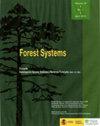持续火灾对热带原生林森林动态和物种组成的影响
IF 0.7
4区 农林科学
Q3 FORESTRY
引用次数: 1
摘要
研究目的:评估近三十年来,森林火灾发生前14年和发生后15年的树种结构、招募和死亡率。材料和方法:1983年、1987年、1989年、1995年、2008年和2012年,在巴西亚马逊东部一片茂密的富营养林中,在12个永久性地块(50 m x 50 m)内对DBH≥5 cm的所有树木进行了鉴定和测量。分析包括所有采样物种及其生态组:耐荫、耐光和先锋物种。通过线性混合效应模型对治疗进行比较。主要结果:火灾后15年的时间不足以使古老的热带森林恢复到火灾前的招募和死亡率条件。火灾后的补充率和死亡率增加,主要是先锋物种的补充(p值<0.05),证实了持续的火灾对该生态系统中的森林动态和物种组成的影响。使用的缩写:DBH(距离地面1.3米处的直径);D(密度);G(基底面积);EG(生态群);ST(shade tole-rant);LD(要求轻);Pi(拓荒者);Ni(未识别生态群);MR(死亡率);RR(招聘率);线性混合效应模型。本文章由计算机程序翻译,如有差异,请以英文原文为准。
Persistent fire effect on forest dynamics and species composition of an old-growth tropical forest
Aim of study: To assess structure, recruitment and mortality rates of tree species over almost three decades, 14 years before and 15 years after a forest fire. Materials and methods: All trees ≥ 5 cm in DBH were identified and measured in 12 permanent plots (50 m x 50 m), in 1983, 1987, 1989, 1995, 2008, and 2012 of a dense ombrophilous forest in Eastern Amazon, Brazil. The analyses were carried out including all sampled species and their ecological groups: shade-tolerant, light-demanding, and pioneer species. Treatments were compared through a Linear Mixed Effect Model. Main results: The 15-year post-fire period is not enough for the old-growth tropical forest to recover its pre-fire conditions of recruitment and mortality rates. The post-fire recruitment and mortality rates increased, mainly the recruitment of pioneer species ( p- value < 0.05). Research highlights: In a period of 15 years after the occurrence of a surface fire, the old-growth tropical forest still has high recruitment rates of shade-tolerant and light-demanding species and high incidence of pioneer species, confirming the persistent fire effects on forest dynamics and species composition in this ecosystem. Abbreviations used: DBH (diameter at 1.3 m from the ground); D (density); G (basal area); EG (ecological group); ST (shade-tole -rant); LD (light-demanding); Pi (pioneer); Ni (non-identified ecological group); MR (mortality rates); RR (recruitment rates); LMM (Linear Mixed Effect Model).
求助全文
通过发布文献求助,成功后即可免费获取论文全文。
去求助
来源期刊

Forest Systems
FORESTRY-
CiteScore
1.40
自引率
14.30%
发文量
30
审稿时长
6-12 weeks
期刊介绍:
Forest Systems is an international peer-reviewed journal. The main aim of Forest Systems is to integrate multidisciplinary research with forest management in complex systems with different social and ecological background
 求助内容:
求助内容: 应助结果提醒方式:
应助结果提醒方式:


